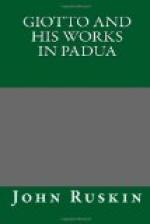C. Close imitation of nature. In this one principle lay Giotto’s great strength, and the entire secret of the revolution he effected. It was not by greater learning, not by the discovery of new theories of art, not by greater taste, nor by “ideal” principles of selection, that he became the head of the progressive schools of Italy. It was simply by being interested in what was going on around him, by substituting the gestures of living men for conventional attitudes, and portraits of living men for conventional faces, and incidents of every-day life for conventional circumstances, that he became great, and the master of the great. Giotto was to his contemporaries precisely what Millais is to his contemporaries,—a daring naturalist, in defiance of tradition, idealism, and formalism. The Giottesque movement in the fourteenth, and Pre-Raphaelite movement in the nineteenth centuries, are precisely similar in bearing and meaning: both being the protests of vitality against mortality, of spirit against letter, and of truth against tradition: and both, which is the more singular, literally links in one unbroken chain of feeling; for exactly as Niccola Pisano and Giotto were helped by the classical sculptures discovered in their time, the Pre-Raphaelites have been helped by the works of Niccola and Giotto at Pisa and Florence: and thus the fiery cross of truth has been delivered from spirit to spirit, over the dust of intervening generations.
But what, it may be said by the reader, is the use of the works of Giotto to us? They may indeed have been wonderful for their time, and of infinite use in that time; but since, after Giotto, came Leonardo and Correggio, what is the use of going back to the ruder art, and republishing it in the year 1854? Why should we fret ourselves to dig down to the root of the tree, when we may at once enjoy its fruit and foliage? I answer, first, that in all matters relating to human intellect, it is a great thing to have hold of the root: that at least we ought to see it, and taste it, and handle it; for it often happens that the root is wholesome when the leaves, however fair, are useless or poisonous. In nine cases out of ten, the first expression of an idea is the most valuable: the idea may afterward be polished and softened, and made more attractive to the general eye; but the first expression of it has a freshness and brightness, like the flash of a native crystal compared to the lustre of glass that has been melted and cut. And in the second place, we ought to measure the value of art less by its executive than by its moral power. Giotto was not indeed one of the most accomplished painters, but he was one of the greatest men, who ever lived. He was the first master of his time, in architecture as well as in painting; he was the friend of Dante, and the undisputed interpreter of religious truth, by means of painting, over the whole of Italy. The works of such a man may not be the best to set before children in order to teach them drawing; but they assuredly should be studied with the greatest care by all who are interested in the history of the human mind.




